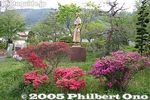Oguchi Taro 小口太郎
|
Title   • File Name • File Name   • Date • Date   • Position • Position   |
|

Oguchi Taro Statue and Biwako Shuko no Uta Song Monument. On the shore of Lake Suwa, Okaya, Nagano. 歌碑と小口太郎銅像This was where I first heard the song, "Biwako Shuko no Uta." In May 2004, I was in Suwa, Nagano Pref. to see and photograph the Onbashira Festival (held every 6 years). My hotel was in the neighboring city of Okaya on the shores of Lake Suwa.
I walked around the lake and came across this statue of Taro Oguchi and song monument. I was very surprised when I saw the word "Biwako" (Lake Biwa). This was Nagano, not Shiga, so it was most unexpected to see "Biwako" here. I read the song lyrics on the monument and was surprised and delighted to see the names of well-known places in Shiga.
The monument even had music box (seen on left) where you could hear three versions of the song. I immediately found it intriguing.
|
|

Taro Oguchi Statue and Song Monument in winter.
|
|

About Taro Oguchi.The song was written as a collaboration among boatmates, but Taro Oguchi (小口太郎) (1897-1924) is credited as being the main song writer. He was born in 1897 (Meiji 30) in Minato-mura village, now part of Okaya city on the shores of Lake Suwa in Nagano Prefecture.
He grew up in a loving and respected family and demonstrated an early talent for writing, music (violin and shakuhachi), and sports (judo, skiing, skating). Since he was the eldest son expected to take over the family home, there was opposition for him to go away for college. However, his father was persuaded to allow Taro to apply for college at the elite No. 3 High School (later to become Kyoto University). It was one of nine college-level schools in Japan, the No. 3 school being one of the most elite.
Contrary to family expectations, Taro passed the entrance exam, went school in Kyoto in 1914 and joined the rowing and speech clubs. In 1917, he wrote the famous song about Lake Biwa which first went public in 1918.
|
|

Statue of Oguchi Taro
|
|

Statue of Oguchi Taro 小口太郎銅像Short walk from JR Okaya Station. Walk toward the shore of Lake Suwa. The monument is near the mouth of Tenryu River.
|
|

Closeup of Taro Oguchi statueHe graduated in 1919 and furthered his studies at Tokyo Imperial University (now University of Tokyo) in the science department. In 1921, he invented the wired and wireless multiplex telegraph and telephone system which was patented in eight countries. He was an extremely bright young man with a promising future.
In 1922, he entered the university's aeronautical research institute as a researcher. However, his life soon took a downturn from 1923 when he received a military conscription notice. A love interest for marriage also did not work out as desired. His physical health deteriorated and he terminated his own life the following year in 1924 at age 26.
|
|

Rear view, looking toward Lake Suwa.
|
|

Side view of Taro Oguchi Statue and Song Monument in spring with azaleas.
|
|

Side view of Taro Oguchi Statue and Song Monument in winter. 小口太郎顕彰碑
|
|

Music box. Three versions of the song can be heard through a speaker by pressing a button. Also see the video at YouTube to hear the song.The monument included a music box where you could listen to three versions of the song through a speaker. I was immediately fascinated by the song when I heard it (together with the wind and waves of Lake Suwa).
|
|

Song monument with the entire lyrics of Biwako Shuko no Uta. On the shore of Lake Suwa in Okaya, Nagano. 琵琶湖周航の歌 全歌詞碑
|
|

Listen to one of the song versions here
|
|

Biography of Oguchi Taro. 小口太郎顕彰碑
|
|

Area of the Oguchi Taro monument (seen on left), in winter.
|
|

Road sign pointing to the Oguchi Taro statue
|
|

Smaller statue of Oguchi Taro inside Okaya City Hall, next to the entrance.
|
|

Neighborhood of Minato where Oguchi Taro lived.
|
|

Oguchi Taro's house (red roof). He lived on the 2nd floor. On the left is a storehouse.
|
|

Path to shrine
|
|
|

Behind this small shrine is a large graveyard full of Oguchi family gravestones.
|
|

Oguchi Taro's grave on right.
|
|

Oguchi Taro's gravestone. He is buried together with his younger brother Sadao.
|
|

Oguchi Taro's gravestone in foreground.
|
|

Oguchi cemetary. This neighborhood is full of Oguchi families, not necessarily related to each other.
|
|

Oguchi graves.
|
|

Scenic view of Lake Suwa from graveyard.
|
|
|
|
|